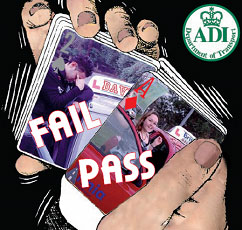
Top tips for passing your Driving Test – At the First Attempt
To pass your driving test you need to drive without making any serious or dangerous faults and no more than 15 minor faults during a drive of about 40 minutes. You must also complete several manoeuvres
Do Your Homework
1. Pin up a map of your test centre area and mark out the test routes. Mark difficult areas on it such as one-way streets, difficult junctions, double mini roundabouts, so that you are ready for them on approach, rather than having to deal with them as if they have come out of nowhere. Make sure you get plenty of practice over the test routes with a professional driving school such as Britannia. Driving Test Centres (address & pass rates) and Driving Test Routes in London South, London South West, Surrey and Middlesex covered by Britannia Driving Schools. Source: Driving Standards Agency (DSA). As an alternative to a conventional map, you can use Windows Live Maps to locate your test centre; many areas are covered by close-up “bird-eye view” photographs, so you can see every roundabout, pelican crossing and box junction on the surrounding roads. You can mark difficult areas on Live Maps using virtual pushpins.
2. Practise manoeuvres until you can carry them out without any minor faults. That will leave you with a margin of 15 faults for the rest of the drive on the day of your test.
3. Practise, practise, and practise until you can drive without verbal or physical intervention from your instructor for the duration of a full driving lesson or a mock driving test. Don’t forget: it’s not practice that makes perfect: it’s practice – with a professional driving instructor – that makes perfect.
Test Day
- Warm up: Arrange to have an hour’s driving lesson around the area of the test centre on the day of your test. This will help you to warm up and get into the swing of things. You will also be aware of any new roadworks, obstructions etc and will feel more able to deal with them more easily. Forewarned is foreamed.
- Nerves: If you start feeling shaky bag of nerves, breathe in, hold your breath, count up to 20 and out breathe out. Repeat this exercise until you gain control of your nerves. Once the test starts, you’ll settle into your driving and your attention will be on the road rather than on your own feelings, and your nervousness should disappear.
- Think confident: Talk yourself – silently! – through the test. Talk about hazards coming up and how you are going to deal with them. This really focuses your mind on how you should be driving in order to pass the test.
- Don’t be afraid to ask: If you don’t understand what the examiner has asked you to do, don’t be afraid to ask him or her to repeat the instruction.
- Think positive:Before you start a manoeuvre, repeat to yourself three times – silently – “this is a piece of cake”. Think positively at all times. You can do it!
- Making a mistake: If you feel you’re messing up a manoeuvre, just pull forwards and do it again correctly. As long as you haven’t done anything wrong, such as touching the kerb or failing to make effective observations, you can still pass.
- Stalling: if, unfortunately, you stall, deal with it and move on. As long as you don’t stall in a dangerous situation, such as on a roundabout and as long as you handle it properly, this needn’t count as a major fault and you can still pass your test.
- Have I already failed? If you feel you’ve made a mistake, don’t instantly assume you’ve failed – it may only have been a minor fault. Put it behind you and carry on driving as well as you can.
- Keep your eyes on the road: Resist the temptation to look at the examiner and what he or she is writing. You will not be able to deduce anything anyway. Keep your attention on your driving and the road ahead!
Do you need more help or advice? Simply click here to contact us and one of our highly trained driving instructors will answer your questions ASAP.
The 10 Most Common Reasons For Driving Test Failure
Reported by the Driving Standards Agency for the 12 months to January 2004
- Observation at junctions – ineffective observation and judgement
- Reverse parking – ineffective observation and/or a lack of accuracy
- Use of mirrors – not checking or not acting on information
- Reversing round a corner – ineffective observation or lack of accuracy
- Incorrect use of signals – not cancelling or giving misleading signals.
- Moving away safely – ineffective observations
- Incorrect positioning on the road – particularly at roundabouts or on bends
- Lack of steering control – steering too early or too late
- Incorrect position to turn right – at junctions and/or in one-way streets
- Inappropriate speed – travelling too slowly or with too much hesitation

 Buy Gifts Vouchers Here
Buy Gifts Vouchers Here Intensive Driving Courses
Intensive Driving Courses Driving Test Booking Services
Driving Test Booking Services


